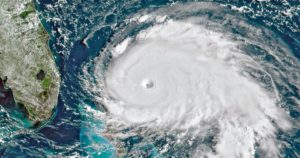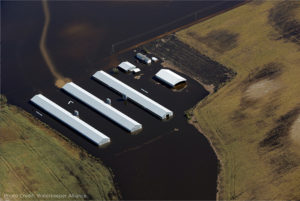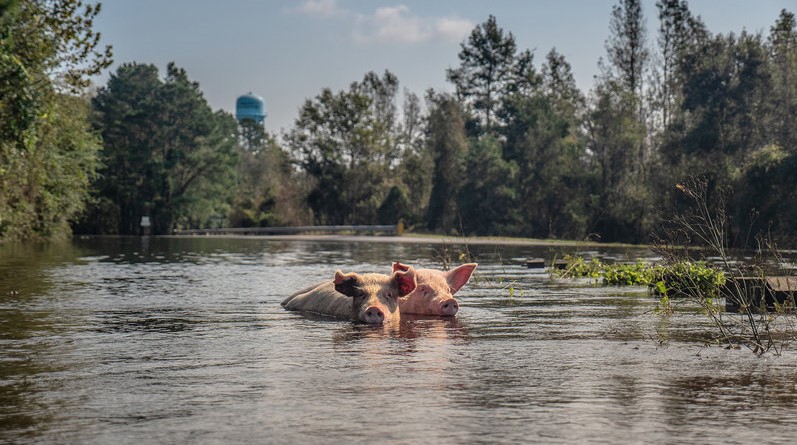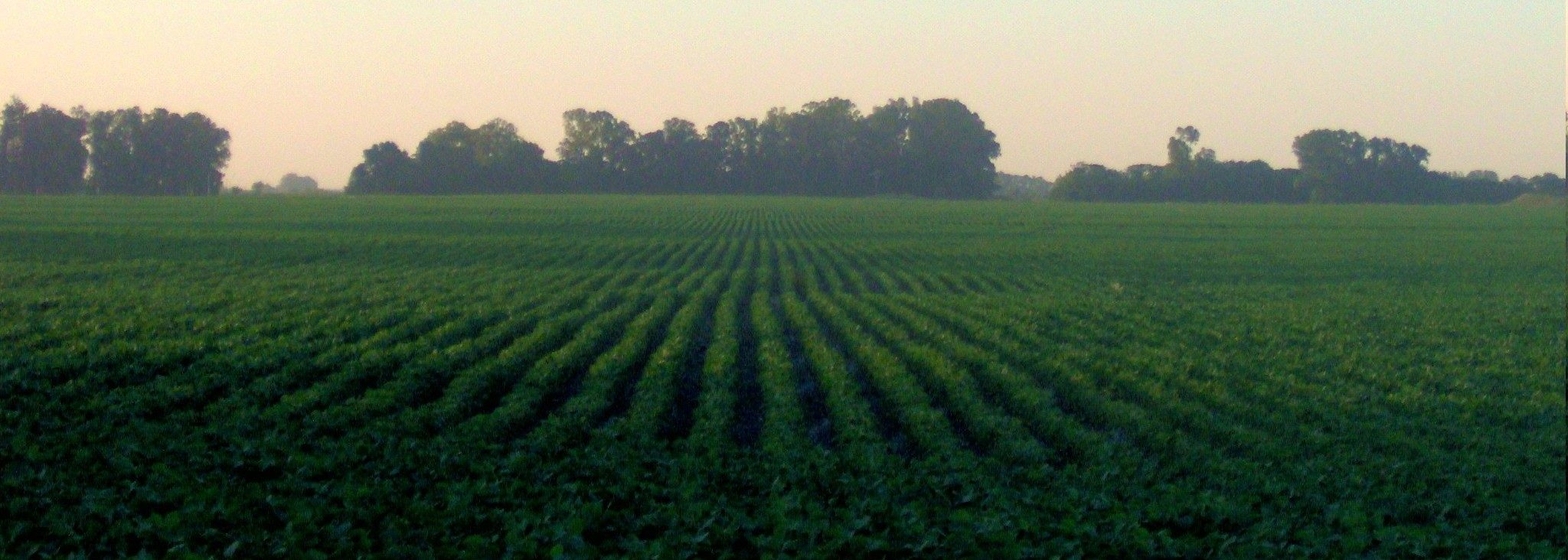Cover Photo: Hogs swimming through floods in Duplin County, NC. NPR | Kelly Guerin
Earlier this month Hurricane Dorian tore through the Southeast United States and the Bahamas. It devastated the Carolinas, spawning nearly two dozen tornadoes and leaving 418,000 people without power in the region. Of particular concern is the massive flooding in North Carolina, a state which ranks second in pork production (after Iowa), second in turkey production, and fourth in broiler (chicken) production.
North Carolina is saturated with CAFOs (concentrated animal feeding operations), many of which are located in a 100- year floodplain. Approximately 10 million hogs, 873.6 million broiler chickens, and 32.5 million turkeys per year are confined within the state. Consequently, North Carolina produces more tons of manure per farmland acre than any other state.

Hurricane Dorian. Flickr | Pierre Markuse
It is surprising that Hurricane Dorian’s effect in the region has generated so little attention so soon after Hurricane Florence destroyed countless communities in North Carolina, primarily due to animal waste and carcasses permeating the floodwater. Florence’s trail of destruction was well-documented. Photojournalists like Jo-Ann McArthur documented the aftermath of the storm – countless bodies of farm animals were left to die. According to the North Carolina Department of Agriculture and Consumer Services, 3.4 million chickens and 5,500 hogs perished.
While communities near CAFOs are still recovering from the ecological and financial impacts of Florence, the government has continued its practice of not only under-regulating CAFOs, but providing a wide array of disaster assistance programs which compensate for losses sustained as a result of hurricanes. These disaster assistance programs provide funds to those that have created the risk of environmental harm, while shifting the costs onto those situated in low-income and minority communities. These communities must deal with the aftermath of flooded manure lagoons, floating animal corpses, and the threats those hazards pose to their property and health – all while their tax dollars go to funding financial relief and cleanup for CAFOs..
CAFOs store animal waste in large piles or unlined lagoons. During extreme weather events like hurricanes, precipitation and flooding cause these lagoons to overflow from rainfall or be swept over by floodwaters. The excess nitrates in the waste cause a host of ecological issues. These concentrated nutrients run off into surface water, causing algal blooms and massive fish die-offs; they also contaminate groundwater, threatening local drinking supplies.

North Carolina CAFO Flooding. EWG reprint of Waterkeeper Alliance
In addition to the environmental impacts of these manure lagoons to water quality, they are equally disastrous to air quality. CAFOs release several air pollutants, including but not limited to: ammonia, methane, hydrogen sulfide, particulate matter, volatile organic compounds and hazardous air pollutants. Many air pollutants released by CAFOs are greenhouse gases which cause CAFOs to contribute significantly to climate change. Despite the impact of animal waste on air and water quality, the vast majorities of CAFOs are not currently regulated under major federal environmental laws such as the Clean Air Act or the Clean Water Act.
These are not the only major exemptions shielding CAFOs from legal accountability. Currently, there are no legal protections for farm animals subject to extreme weather events. No laws require farmers to have a contingency plan in place regarding the welfare of farm animals trapped during storms, let alone requiring them to move those animals to safety. Often, sheltering or evacuation of animals must be done before humans are evacuated. This is a very cost and energy-intensive process.
Generally, governmental agencies will not issue such directives for animals before similar instructions are issued for people out of fear that a panic situation might occur and people might be critical about why the animals are being protected before them. The result is that animals are left (and sometimes locked) inside pens, cages, and sheds. In the case of chickens, those that do not drown often asphyxiate due to severe air contamination. Chicken feces contain such high levels of ammonia that chicken CAFOs need constant ventilation to keep the people and chickens inside from asphyxiation. When these facilities lose power and ventilation ceases, the air becomes toxic and the chickens left inside will asphyxiate in a manner of minutes. Animals that do not drown or asphyxiate are forced to stand in contaminated flood water. They are at increased risk of harm and develop infections. As carcasses begin to degrade, bodily fluids, naturally and unnaturally occurring chemical, biological, and radiological leachate components, as well as hazardous gases may be released into the environment, potentially impacting the health and safety of surrounding humans, livestock, and wildlife.
Even in light of the havoc thrust on countless animals and communities due to the actions and inaction of CAFOs, the government continues to provide assistance and funding to assure that they continue to operate at a minimal loss. The USDA offers a Livestock Indemnity Program, authorized by the 2018 Farm Bill, which provides compensation to livestock producers for livestock deaths in excess of normal mortality caused by adverse weather. They receive compensation equal to 75 percent of the average fair market value of the livestock.
The 2018 Farm Bill also authorized the Emergency Assistance for Livestock, Honeybees and Farm-Raised Fish Program, which assists livestock producers by compensating for losses from adverse weather that are not covered by other disaster programs. In addition to federal disaster relief, states have funding available to farmers in the wake of natural disasters, such as the Hurricane Florence Agricultural Disaster Program of 2018, which provided $240 million for direct assistance to farmers in the wake of Hurricane Florence. The USDA also provides technical assistance to farmers who have abandoned their animals and are struggling to undertake the hazardous cleanup.
Other arms of the federal government have also been instrumental in providing resources to clean up dead animals. After Hurricane Florence, FEMA agreed to pay up to $20 million to turn 4.2 million dead chickens and turkeys into compost.
The government’s action and inaction in this area promote both ecological disaster for the local community and the cruel demise of millions of animals left behind. Even after America lamented the “heartbreaking” aftermath of Florence, little has been done to change actual practices and behaviors.
Without regulations that place heightened requirements on waste storage and the pollutants discharged into the water and air and regulations encouraging or requiring that CAFOs take adequate measures to shelter or evacuate farm animals rather than leaving them behind, communities and animals will continue to suffer the consequences and bear the cost. If the government fails to establish these regulations, reimburses CAFOs for animals lost during natural disasters, and takes the lead in cleaning up the mess, CAFO owners have little to no incentive to adequately prepare for disaster or take measures to prevent ecological disaster. Why invest in better storage for waste? Why take on complicated and expensive evacuations?
By continuing to provide millions in federal aid to compensate CAFOs after natural disasters, the government is in part endorsing the subsequent environmental destruction and harm inflicted on countless forsaken animals.


